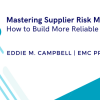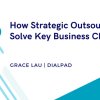The primary goal of a procurement function to achieve savings carries greater significance in a recession when obtaining the lowest cost possible needs to be balanced with not compromising the quality of products and services delivered by suppliers. A secondary goal could be supporting major technology transformation projects. These goals are made more difficult when economic disaster strikes.
In an environment where budgets are reduced and cost mitigation measures introduced, the objectives of procurement must be fully aligned with the strategy and direction of the organization. Some may consider procurement driving savings and pushing for the continuation of a key technology project a high-risk maneuver.
I believe it is an opportunity to deliver value.
Understand the Success Factors of Major Projects and Optimize Opex
Transformation Projects are considered business priorities with organizations making investment decisions based on the benefits and fiscal return to the organization, deploying strategies and frameworks to implement them. In October 2018, McKinsey published the Unlocking Success in Digital Transformations Survey that highlighted the success rate for transformation projects is less than 30% and only 16% of respondents said their organizations’ digital transformations were successful. The survey reported that having the right digital-savvy leaders in place, empowering people to work in new ways and frequently communicating via traditional and digital methods as the keys to "successful transformation projects."
Unlike the depreciation of capital expenditure, operational expenditure (opex) is usually fully tax-deductible in the year it occurs. Many companies have pivoted from traditional hardware and software ownership to "as a Service" with opex consumption models freeing up capital budgets for revenue-generating projects. Furthermore, by shifting IT operational capabilities to a supplier in an opex environment, the responsibility for purchasing capital items (e.g., system upgrades or repairs) mainly lies with the vendor.
In October 2017, San Diego Tourism Authority CIO Isabel Sauerbrey told ZDNet how the organization was able to move its 10-year-old ERP system to the cloud by saving money on hosting and support with no capital outlay. Sauerbrey said, “By making these efforts, it has enabled our IT team to focus on innovation, reduce development costs and avoid spending time doing maintenance.” Make every dollar count by engaging with companies that offer commercial constructs aligned with the funding model and cash flow position of your organization. Transformation and opex savings are achievable!
Consider Technology Disruption the Solution to the Interruption
Disruption in technology provided organizations with the opportunity to break from existing processes and structures, adopting new operating practices facilitated through internet-enabled business models. The ubiquitous access to smartphones permitted businesses to improve their delivery of services to their customers. Digitization has enabled organizations to operate during the current crisis. For example, schools and universities can continue teaching through online platforms and communicating with students through Zoom.
In January 2018, MIT Sloan Management Review published its research on business preparedness for disruption, which identified that 87% of corporate executives expected disruption, with only 44% prepared for the disruption. I asked Matthew Rogan, CEO of Business Transformation company Laevo about the survey in the context of COVID-19. Matthew told me, “It is my assumption that respondents would have been thinking in the 'tech' disruption space, as opposed to a global pandemic that we are seeing at present.” Matthew explained how business continuity is generally planned for short periods of impact, a one to two week "alternate" working arrangement, and not two months and a while away from returning to "normal." A more connected workforce and technology landscape are required.
The long-term viability of organizations will largely depend on their ability to adapt and meet the demands of their customers with digital engagement now a fundamental requirement. Disruption is no longer about who stands to win or lose. Social distancing and restrictions on public gatherings have contributed to reducing the spread of COVID-19 with technology introduced through disruption enabling people who are isolated from their families to safely “connect” with their loved ones. In the recent past, organizations may have had time on their side to respond to disruption. A pandemic is a rare emergency with prompt and deliberate action required by businesses to ensure the health and safety of employees and customers. The return to "normal times" requires technology disruption to be considered an ally and not a threat.
Hard Savings Are More Attainable Through Collaboration
The sales and sourcing landscape have suddenly changed with the emergence of a buyers’ market. In order to maximize the opportunities for delivering savings that help the bottom line, an integrated approach of engaging stakeholders and suppliers in difficult conversations is required. Last year Beroe published an article outlining the need for Procurement-Expert-Generalist recommending a focus on strategic initiatives and considering the broader picture. Business Partnering and Supplier Coach are two of the key capabilities required with cost-saving skills deemed mandatory for the procurement team. In a deep recession, stakeholders appreciate the urgent need for change, and strategic suppliers understand the upside of savings is customers are more likely to survive and be able to buy in the future. In my experience, a business seldom operates like this.
Less interest from buyers means suppliers need to adjust their prices more competitively, meeting the amount a customer can afford to pay. Having the right information and data is vital to driving and holding costs down while preserving or enhancing customer value on an ongoing basis. Help stakeholders and suppliers identify their respective cost drivers and where there are opportunities to achieve mutual efficiencies with both parties committed to eliminating duplication and waste. Firmly negotiate and compromise where appropriate. Recognize that a short-term saving should not impact the ability of a supplier to deliver as organizations will need its strategic suppliers to scale up operations when the economy starts to recover. Every deal must align with the strategy and contribute to a business outcome.
Think clearly about the goals and culture of your organization. The circumstances surrounded by a recession are extremely challenging and present both a threat and an opportunity. Effective leaders succeed through making informed decisions by carefully assessing risks and taking advantage of the situation. Not acting is a worst-case scenario. A bold and motivated procurement team is well placed to serve their organization when they need it most. Stakeholders and suppliers will value the people who helped save the business.









